Our main reason for heading to Chiclayo had nothing to do with the beaches, nice as they were. We wanted to visit the archaeological sites for the Lord of Sipán, who was the ruler of the Moche culture in this area a whole lot o’ time ago – somewhere between 100-700AD. The site of his tomb was discovered in 1987 when a couple of thieves tried to pawn what turned out to be close to a million dollars’ worth of gold and silver items – turned out they’d discovered the burial site of the culture and had been raiding it. Governments and archaeolgists stepped in, and over time, they’ve uncovered 15 tombs including the famed Lord himself, as well as the “Old Lord”, his great-great uncle or thereabouts.
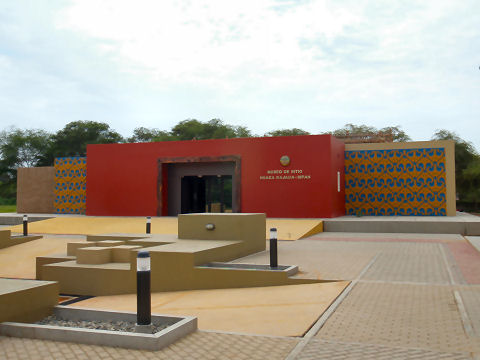
First stop, the onsite museum, which is primarily an explanation of the culture, what was found, and replicas of many of the items that were found. Some of the items on display are the real thing, but very few. The primary purpose of the museum seems to be to give you an orientation before heading out into the site itself.
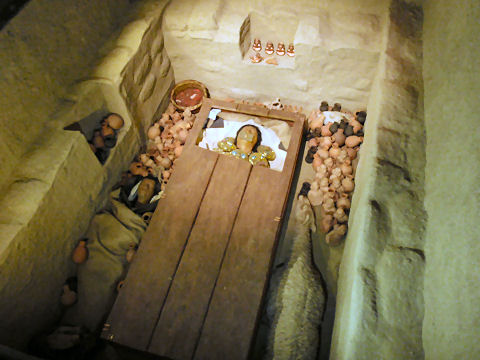
An example, this is a re-creation of the Lord’s crypt itself. Compare to the “onsite” mockup coming up.
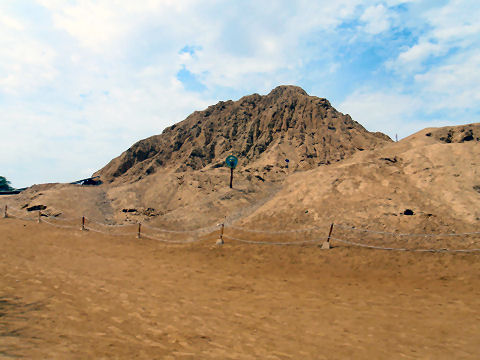
This is Tumbas Reales, the hill, or pyramid, in which five levels of tombs have been found, including, as mentioned, the Lord of Sipán, the Old Lord of Sipán, and the high priest of the culture.
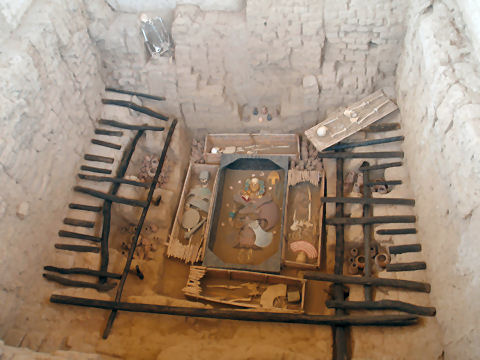
This is the Lord’s tomb itself, mocked up to show how things were actually found. He was buried with his wife, two concubines, his son and a pet dog, a llama and a couple of slaves. The tomb was then covered over with logs from local carob trees, and then in the upper right you see the skeleton of the tomb’s warrior guard, and in the upper left, seated in an alcove, the skeleton of the tomb’s spiritual guard.
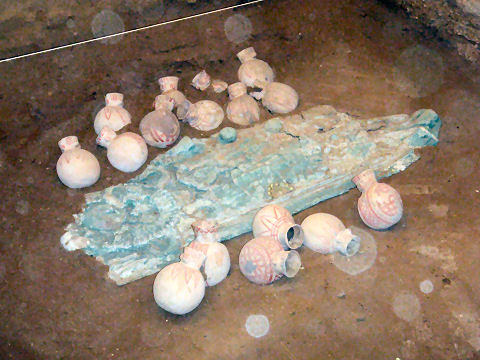
This is the Old Lord’s tomb – much simpler, and from roughly 150 years before. He was not adorned in battlegear or any of the various other accouterments of his great, great nephew but wrapped in a decorated cloth and buried with his wife and some supplies for the journey into the next life.
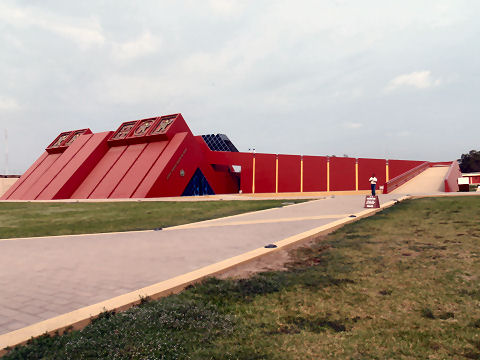
This is the main museum for the site, a world-recognized archaeological museum. It’s heavily guarded, and, in fact, you can’t take in any cameras, cellphones, or other mechanical or electronic devices. And they do a metal scan out in the parking lot, and followup with a pat-down if they think it’s necessary. Refusal to leave behind your stuff in your car/van or whatever results in you being re-routed to a basement entrance where they take everything away from you or turn you away. A young Norwegian couple in our tour group refused to leave their bags in the van, despite it being guarded, announcing loudly that they were sure it was a setup to be robbed by “the Peruvian thieves” – they weren’t allowed in, and were summarily returned to town at their own expense in a cab rather than being allowed to continue the tour. In the museum, literally thousands of pieces recovered from the site – including the actual bones and apparel of those buried there to various objects buried with them – ceramic, copper, gold, and silver being the most common, but plenty of precious and semi-precious jewels as well.
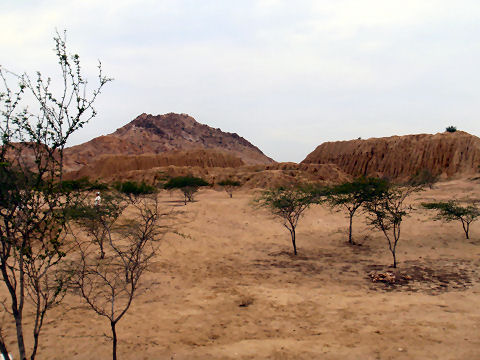
From there, on to Túcume, the site of the pyramids of the culture of the same name. This is a series of pyramids spread out over a 150 square kilometer area, ranging from these central “administrative and spiritual” ones, to various ones that served daily life functions for the culture.
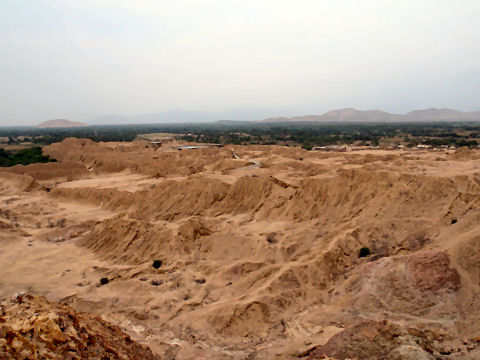
The most interesting is called the huaca larga, or long temple. It is touted as the largest brick structure on the planet – 750 meters in length, 280 in width, and 35 in height. It’s being excavated now, so there wasn’t a lot of information available other than that it served as the main center of commerce for the area.
And that was the day, other than food…
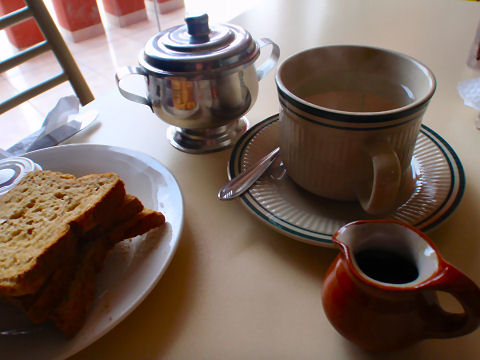
A step up from Santiago’s ubiquitous instant coffee is northern Peru’s café pasado. It’s a concentrated syrup of coffee, basically a pot gets boiled down to a syrupy consistency. You get about an ounce of the stuff served in a little jug along with a cup of hot water and some sugar – mix to your heart’s content.
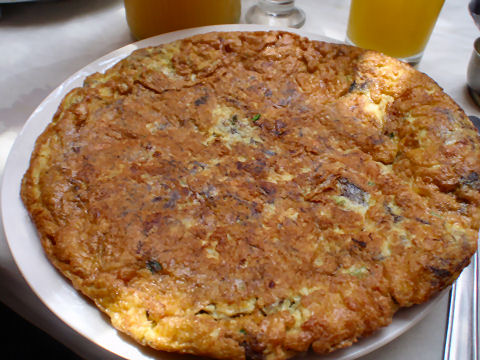
We stopped mid-day at a fun place in the midst of Lambayeque, near to the main museum, called El Cantaro. Specializing in local dishes, we opted to cover the table with a selection. The most interesting, in my view, this tortilla de lango-ray, a shrimp and skate omelette, and…
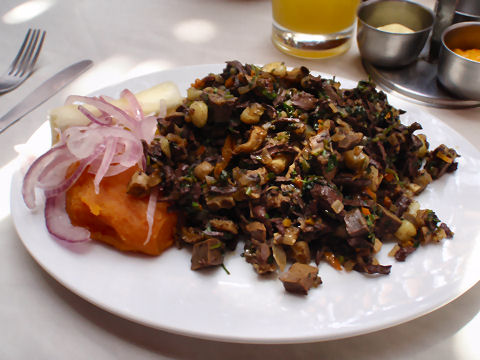
…chirimpico, which, well, this is for the offal lovers out there – a chopped mix of baby goat’s heart, liver and intestines that are stewed with the blood of the same goat and then mixed with cilantro, peas, squash and chilies. It was… really, really good. In fact, I think it was the only plate on the table that we completely finished.
Next, on to the Amazon hills….
Love reading about your trip! Hope to get to Peru someday. I linked to your pionono de pollo on my blog today. Cheers!
[…] or, our waitress just screwed up), and a café americano, which here turned out to be a café pasado, albeit fancily served in a chemistry […]
[…] one other time I tried chirimpico it was when we were in Chiclayo a few years ago. It was a slightly dry style stew of baby goat […]